Cookies help us deliver our services.
By continuing to browse this site, you agree to our use of cookies.
Home / Destinations / Japan / A Naoshima Itinerary – The Best Things to Do on Japan’s Art Island
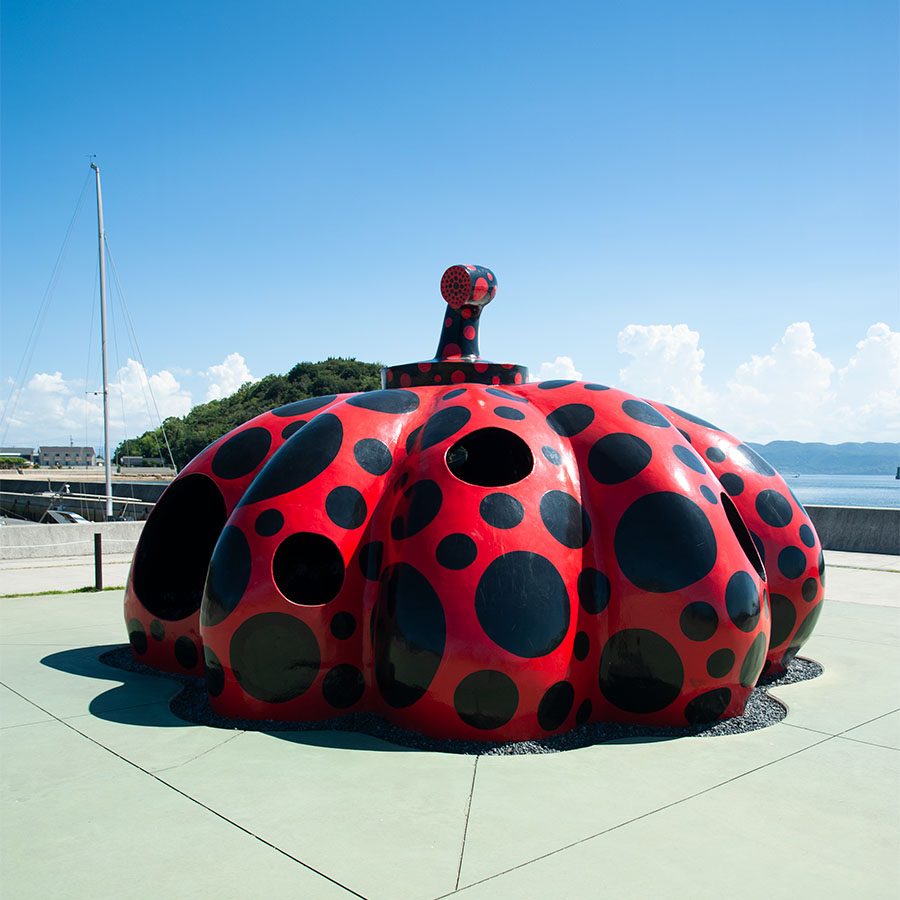
The small island of Naoshima has become famous as Japan’s art island. As our Naoshima itinerary will show, art is a pretty big deal here, thanks to the two iconic red and yellow pumpkins that sit on its coastline and the island’s three major art galleries.
Exploring the island’s many galleries, playful public artworks and the numerous houses that have been converted into art installations are high on the list of things to do in Naoshima.
If you have the time, the neighbouring arty islands of Teshima and Inujima are also well worth exploring during a trip to Naoshima.
Naoshima is one of a cluster of small islands located in the Seto Inland Sea in between two of Japan’s main islands, Honshu and Shikoku.
The nearest major city to Naoshima is Okayama, which is almost exactly halfway between Kobe and Hiroshima. From Okayama it takes around an hour and a half to reach Naoshima by a combination of train and ferry.
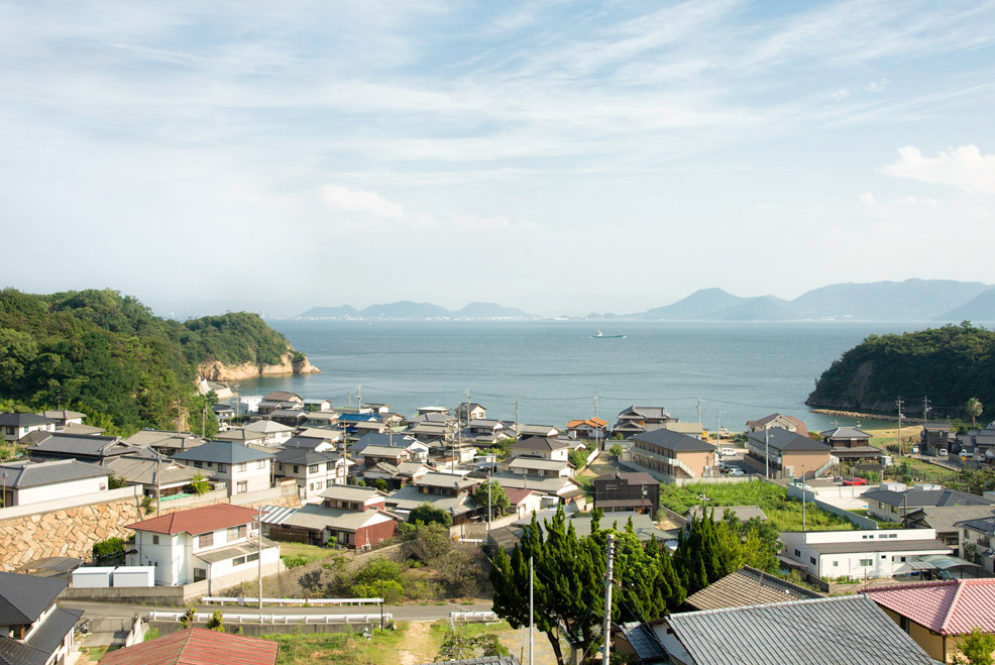
We recommend staying on Naoshima for at least two days.
Many people visit Naoshima on a day trip but due to the time it takes to reach the island – as well as the amount there is to see here – we’d recommend at least staying for one night.
Two days on Naoshima will give you enough time to take everything in at an enjoyable pace. Otherwise you’ll likely to be rushing around the island trying to cram in as much as you can before the last ferry leaves for the day.
For the perfect Naoshima itinerary we’d also recommend planning to stay for a third day to visit the nearby islands of Teshima and Inujima too.
Just like Naoshima both Teshima and Inujima are packed with inventive modern art galleries and gorgeous scenery.
If you do decide to stay on the island overnight then there’s a good selection of accommodation in Naoshima.
You can search for accommodation in Naoshima by clicking here but if you need a few suggestions here are a few places that we recommend:
Budget
Guest House Shimayado Aisunao is a simple yet comfortable guest house with plenty of lovely arty touches right in the heart of Honmura with the Art House Projects right on the doorstep.
Rooms come with a Japanese breakfast and the staff are very friendly and helpful. The guest house is part of the vegetarian Aisunao restaurant we recommend below.
Next Level
Just a few minutes’ walk from Miyanoura port, MY LODGE Naoshima is a fantastic, modern hotel with stunning views out across the sea. Rooms are large and beautifully decorated, kitted out completely with furnishings from Muji.
It’s worth adding the excellent breakfast which will set you up for a day exploring the island. This is one of the most popular places to stay on Naoshima.
Traditional
For a traditional stay on Naoshima check in at inn Hoshikuzu, a beautiful old Japanese house with tatami rooms and futons, along with plenty of mod cons such as free wifi, air con and private bathrooms.
Conveniently located, inn Hoshizuku is tucked away among the quiet back streets of Miyanoura just a few minutes’ walk from the ferry port.
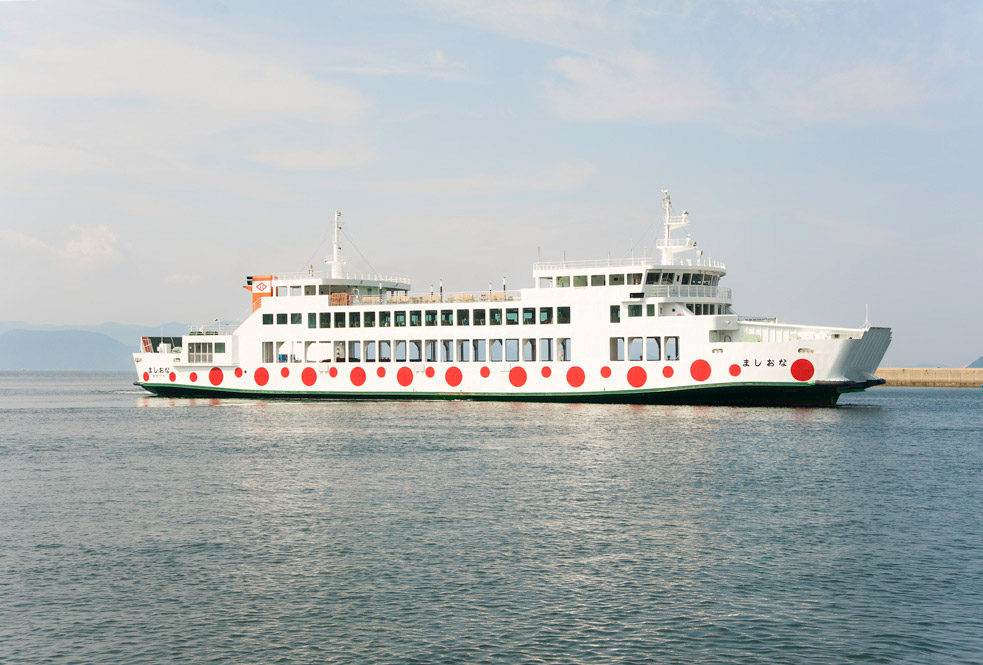
The easiest way to reach the art island of Naoshima is via the city of Okayama. Okayama can be easily reached from major cities such as Tokyo, Kyoto, Osaka and Hiroshima via the Shinkansen.
From Okayama take a local train to Uno Station, the last stop on the Uno Line (this sometimes requires a change at Chayamachi station on the way).
At Uno, take the ferry from the port that’s located just a few minutes’ walk to the south of Uno Station.
There are a number of boats to Naoshima from Uno every day which take between 15 to 20 minutes to reach the island.
There are two types of boats that go to Naoshima – large ferries that allow passengers, bikes and cars on board and the smaller and speedier passenger boats that are for passengers only. A single fare for passengers is just ¥300 regardless of which type of ferry you take.
A timetable of ferries to and from Naoshima from Uno (as well as to all other destinations from Naoshima) can be found here.
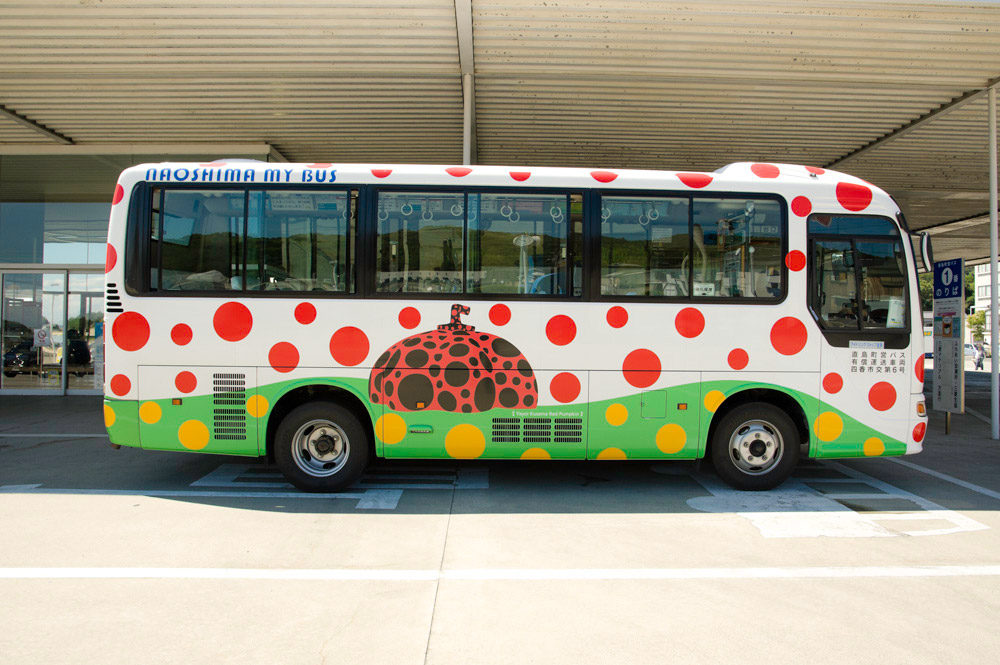
Though Naoshima is a small island you will need to rely on some form of transport to get around. The cheapest way to get around Naoshima is by bus.
A public bus service operates between Miyanoura port, Honmura port and Tsutsuji-So bus stop, near the yellow pumpkin and eastern entrance to the Benesse House art museums. There’s a flat fee of ¥150 per journey.
The three main art museums on Naoshima are all on private land and a free shuttle bus runs between them several times a day. Timetables for the public bus and the museum shuttle bus can be found here.
A popular way to get around Naoshima is by bike. There are several bicycle hire shops in Naoshima, located opposite the two ferry ports. Electric bikes are the most popular option due to the number of fairly steep hills on Naoshima.
Electric bikes can be hired for ¥1,100 a day from Ougiya and ¥1,500 a day from TVC, both of which are directly opposite Miyanoura ferry terminal. TVC also have a bicycle hire store next to Honmura ferry port.
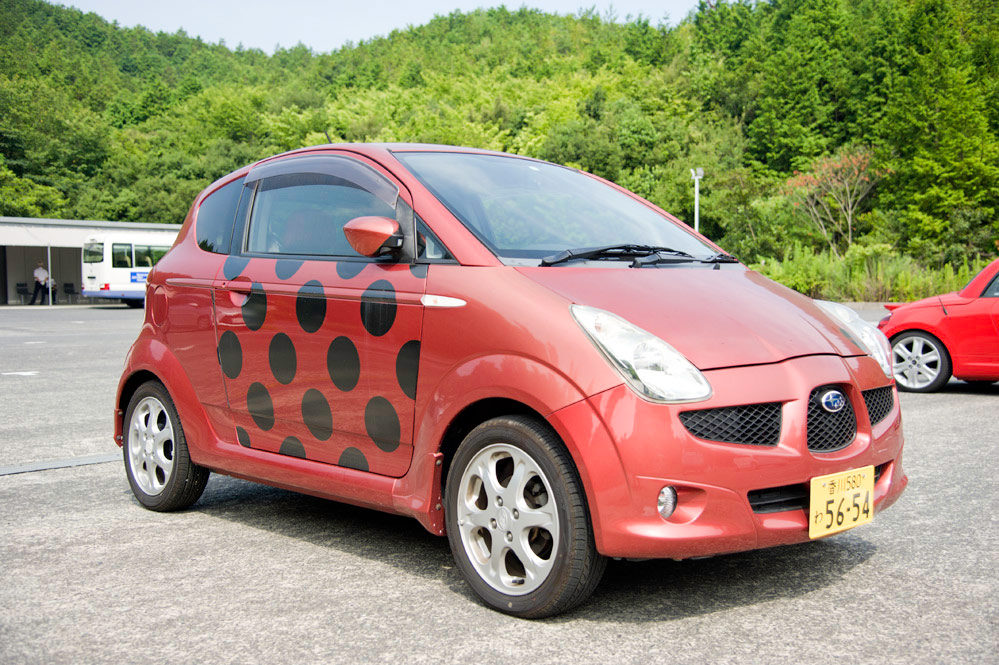
If you have an international drivers’ license you can also hire a car on Naoshima which is by far the easiest way to get around the island.
As well as bikes, you can also hire a car from Ougiya, who have a selection of two and four-seater cars available, including some that come in an obligatory red and yellow spotted design. Car hire costs ¥6,600 for the day, and there are free car parks next to or near most of Naoshima’s main sights.
One thing to be aware of is that all of the major art museums and galleries in Naoshima are closed on Mondays.
If you’re heading to Naoshima for a day trip do not visit on a Monday. If you’re visiting for a couple of days and one of them is a Monday then jump on a ferry to Teshima and explore that island on that day instead.
Secondly, make sure you bring any emergency supplies that you might need with you. There are very few shops for everyday essentials in Naoshima beyond two small supermarkets and just the one 7-Eleven convenience store.
There are also no chemists or pharmacies on the island either, so if you rely on any kind of specialist medication or even painkillers or insect repellant then be sure to bring them with you.
Teshima and Inujima islands have even less than Naoshima, with no convenience stores or supermarkets on either island.
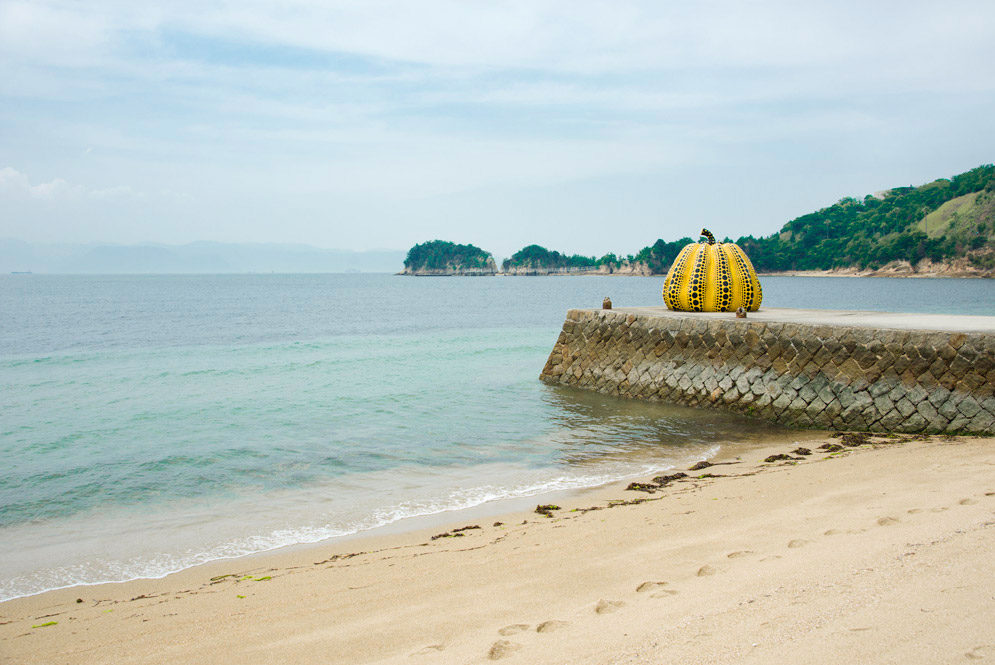
The art island of Naoshima is most famous for its two giant pumpkins and the major art galleries of Benesse House, the Chichu Art Museum and the Lee Ufan Museum.
Home to a world of fabulous contemporary art, the three museums are grouped together on the south west of the island, beautifully designed to complement Naoshima’s spectacular natural beauty.
There are also a number of other sights to see around the island’s two ports, Miyanoura and Honmaru. Miyanoura is the busier of Naoshima’s ports as more ferries to the mainland and to and from other destinations stop here.
Over on the west side of the island, Honmura is home to a number of Art House Projects, a series of traditional Japanese houses and buildings that have been converted to occupy fun and playful art installations.
Our Naoshima itinerary starts with the island’s major art galleries and famous Yellow Pumpkin before moving on to the best things to see and do in Miyanoura and Honmura.
We’ll also visit the neighbouring islands of Teshima and Inujima for the complete guide of the best things to do in Naoshima.

Naoshima’s three major art galleries on Naoshima are all located together on the south western edge of the island.
All three galleries are a stunning example of sleek and stylish modern architecture, each designed by the Japanese architect Tadao Ando and carefully built in harmony with the island’s natural environment.
Benesse House Museum houses a wide range of contemporary artwork in a number of different genres and styles.
Paintings, sculpture and photographs are displayed alongside specially commissioned art installations which are often connected to the scenery and geography of Naoshima.
Benesse House Museum’s collection includes works by numerous artists from all over the world, including David Hockney and Andy Warhol.
The artworks are cleverly displayed in indoor and outdoor spaces throughout the building and there are several more dotted around the nearby beaches and the grounds of the Benesse House Hotel (though some artworks are in areas reserved for guests only).
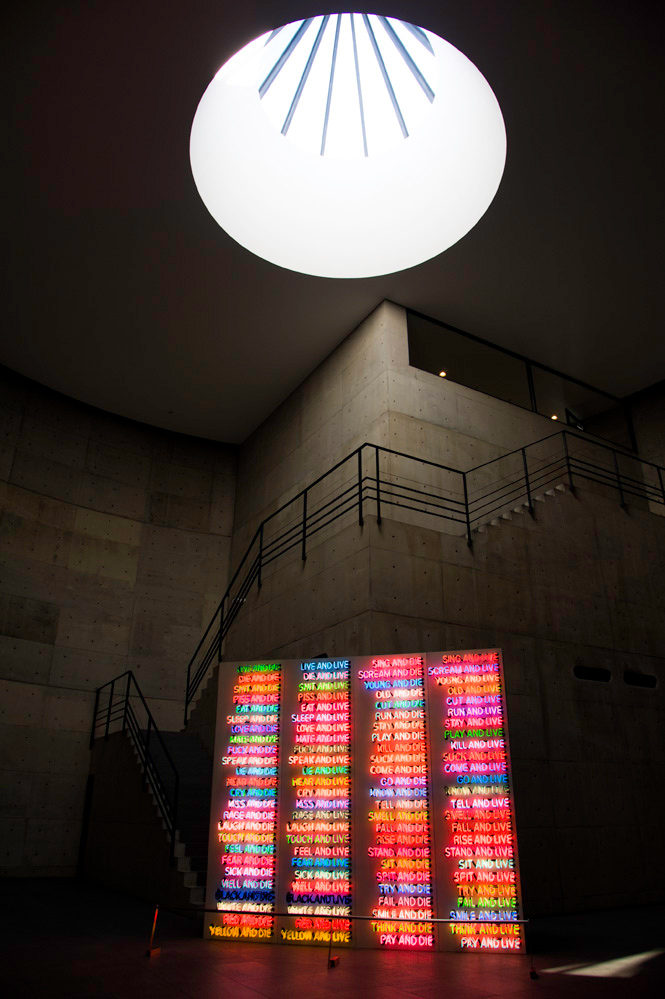
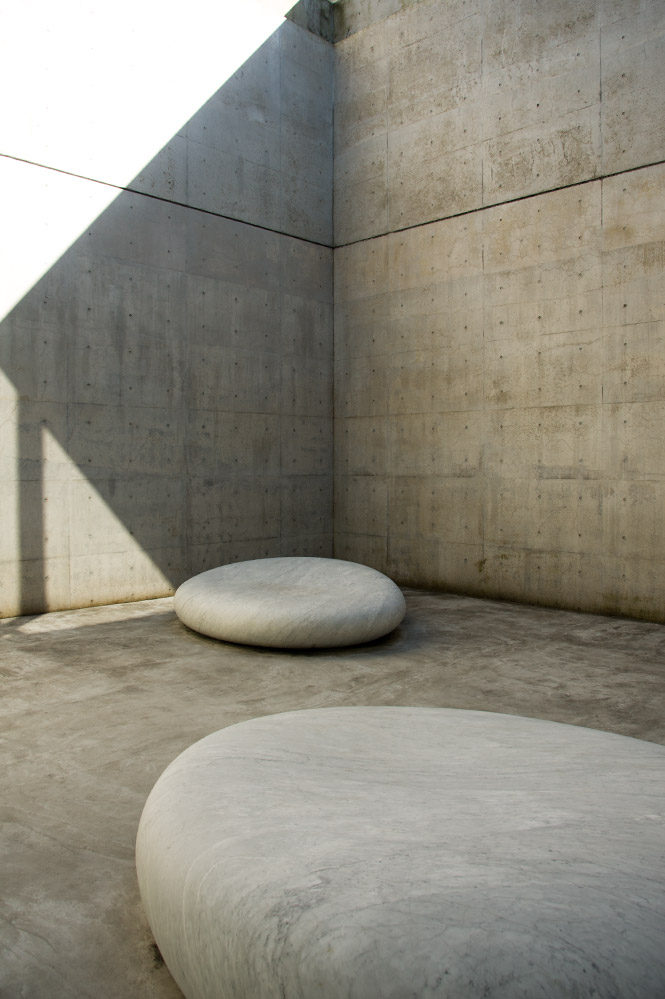
The Chichu Art Museum features a number of large-scale immersive artworks as well as five large paintings by Claude Monet as part of his Water Lilies series.
Largely underground, the Chichu Art Museum’s smooth concrete design is almost a part of the art.
This is especially true for the artwork created by Walter De Maria, which fills an entire enormous room.
The museum also has three artworks by the American artist James Turrell who uses space along with natural and artificial light to wonderful effect.
Lee Ufan is a Korean contemporary artist who has lived and worked in Japan. This museum is another collaboration between the artist and the architect Tadao Ando.
Together they have combined to create the Lee Ufan Museum, where the modern artworks and the spaces where they’re displayed perfectly complement each other.
On display are several of Lee’s two dimensional paintings and sculptures created throughout his career from the 1970s up to today.
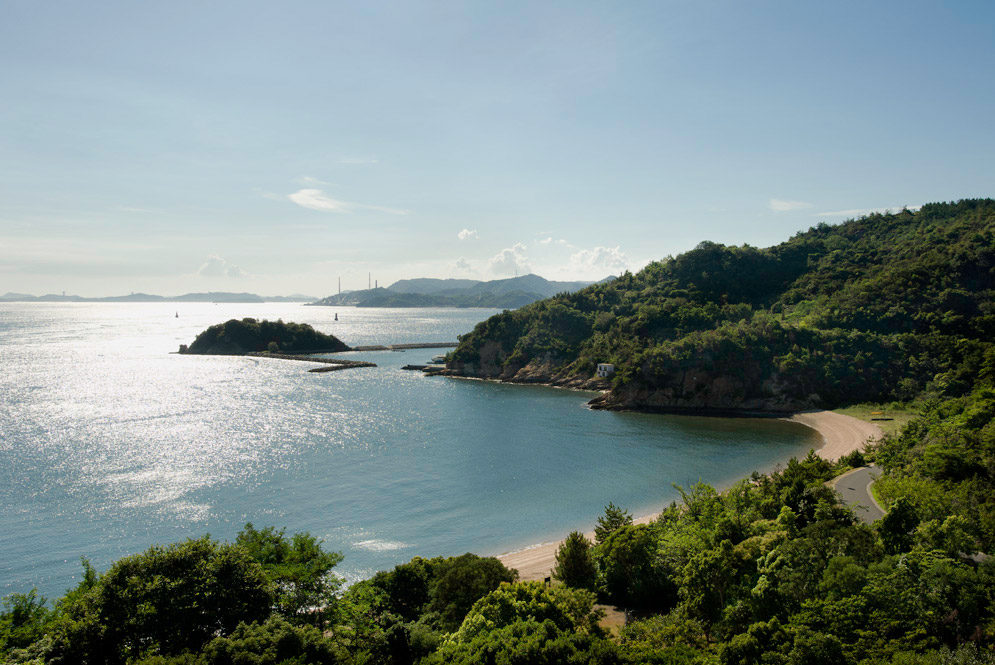
Benesse House, the Chichu Museum and the Lee Ufan Museum are all located together on private land on the southern end of the island.
The road that connects the three museums is not open to traffic, meaning that you’re not allowed to drive or even cycle to each museum.
However, a free shuttle bus runs between all three museums throughout the day. If you wish you can walk between the museums, though the distance and the number of hills between them means that it’s quite a trek.
The free shuttle bus runs back and forth from the Chichu Art Museum ticket centre at the northern end of the complex and Tsutsuji-So bus stop near the eastern entrance to the Benesse site.
If you’ve hired a bike or a car it’s probably easiest to park at the Chichu Art Museum ticket centre and take the shuttle bus from there.
If you’re relying on public transport, the easiest option is to take the bus to Tsutsuji-So bus stop and then transfer on to the shuttle bus from there.
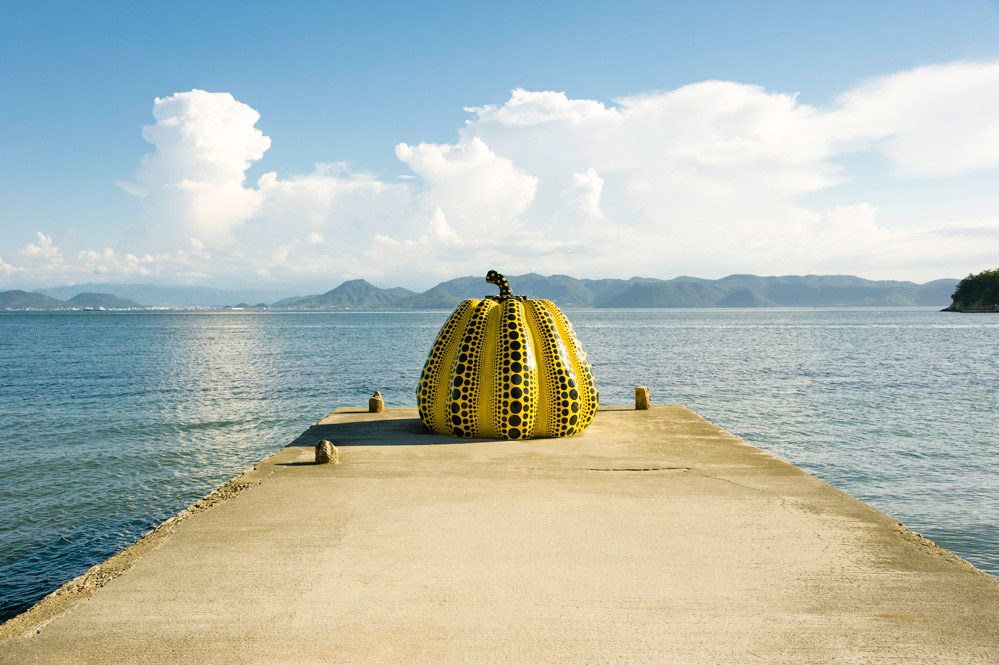
Near the top of every Naoshima itinerary is a photo with the island’s most famous landmark.
At the far end of the Benesse site, a short walk along the beach from the Tsutsuji-So bus stop you’ll find the Yellow Pumpkin, created by Yayoi Kusama, one of Japan’s most famous artists.
Sitting on the end of a small pier, the Yellow Pumpkin has become the unofficial symbol of the island and is arguably one of the most famous artworks in Japan.
The Yellow Pumpkin was created by Kusama in 1994 and installed here in the same year.
Since then the pumpkin has become an iconic part of Naoshima’s landscape, sat in front of the Seto Inland Sea’s many distant islands and numerous passing ships.
A strong typhoon hit Naoshima in August 2021, sending Kusama’s Yellow Pumpkin into the sea. Though the pumpkin was rescued, it was badly damaged and needed extensive repair.
Thankfully, after over a year away, Kusama’s famous yellow pumpkin was returned to its rightful place in October 2022.
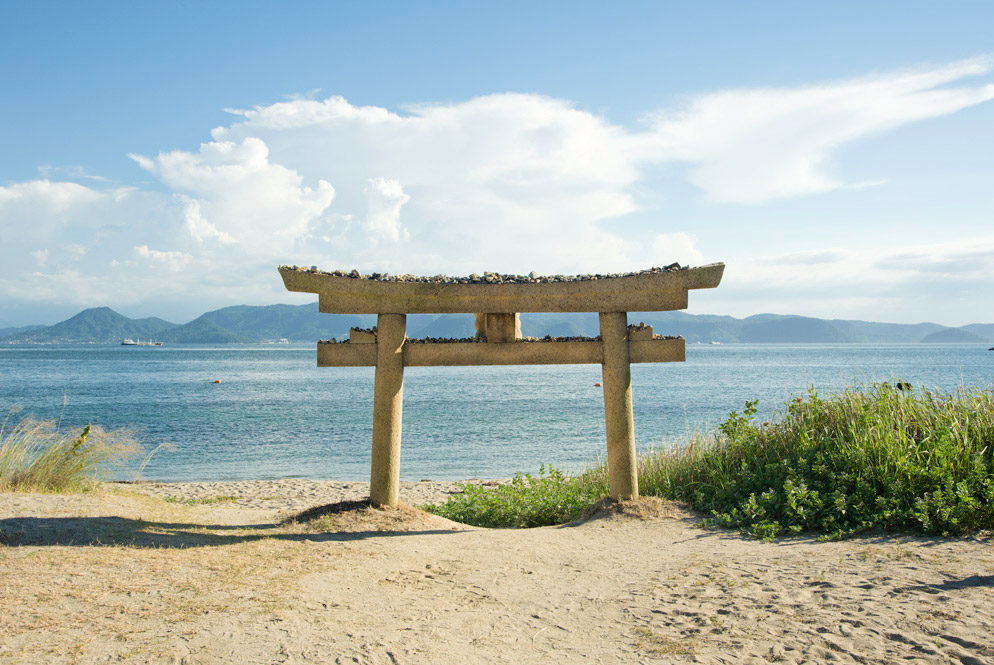
Right next to the Yellow Pumpkin is Gotanji Swimming Beach. If you fancy taking a dip in the sea or just want to laze a little on the beach whilst you’re in Naoshima then this is the place to do it.
Gotanji beach is the largest beach on the island and the pristine sands are a perfect place to relax.
The sea here is safe for swimming and there are various facilities such as vending machines, bathrooms and showers too.
Along with the views of Shikoku, don’t miss the nearby Ebisu torii gate that is half submerged into the sand.
Most people will arrive in Naoshima at Miyanoura on the east side of the island as this port has the most ferries from Uno on the mainland.
The modern ferry terminal is home to a tourist information office, a small café, a souvenir shop as well as toilets and lockers for luggage. Just outside the ferry port is where all of Miyanoura’s main sights lie.
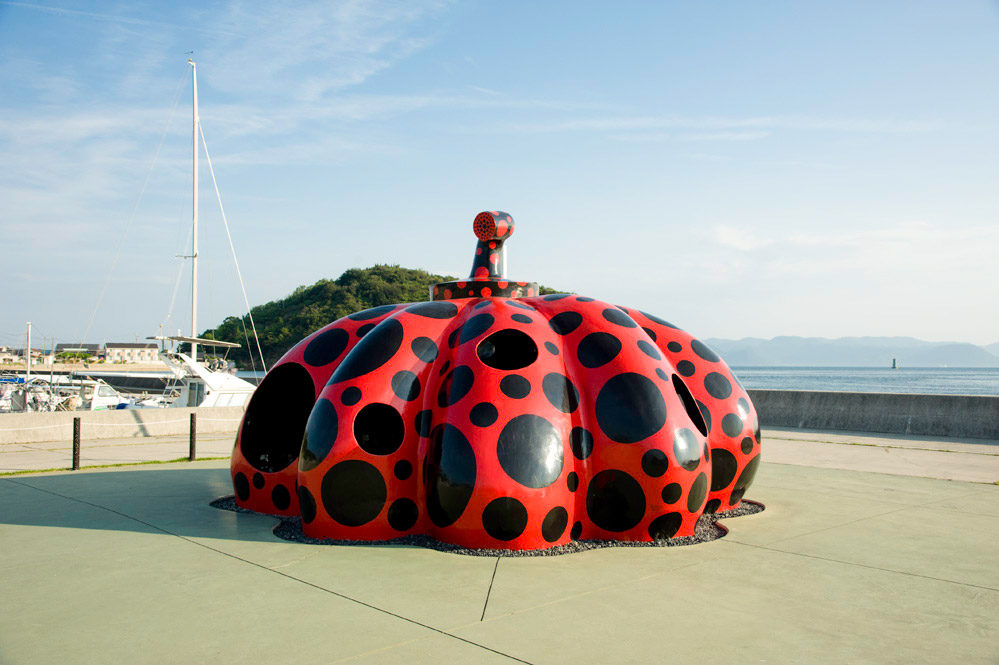
Just outside the ferry terminal building next to the seashore is Naoshima’s giant Red Pumpkin sculpture, the other of the two famous artworks by Yayoi Kusama.
Yayoi Kusama is probably the most famous Japanese artist of all time, and thanks to her two oversized pumpkins she has become synonymous with Naoshima.
The Red Pumpkin is the larger of the two, with an open space to walk around inside and holes that you can pop your head through. The deep red of the pumpkin dazzles on sunny days and contrasts nicely against the brilliant blue sunshine.
Nearby are two other public artworks, the Bunraku Puppet and the Naoshima Pavilion. The Bunraku Puppet is a modern art sculpture by the contemporary Portuguese artist Jose de Guimaraes.
Bunraku is a traditional form of Japanese puppet theatre that originated in Osaka in the 17th century. The sky-blue Bunraku Puppet sculpture is inspired by the movement of the puppet.
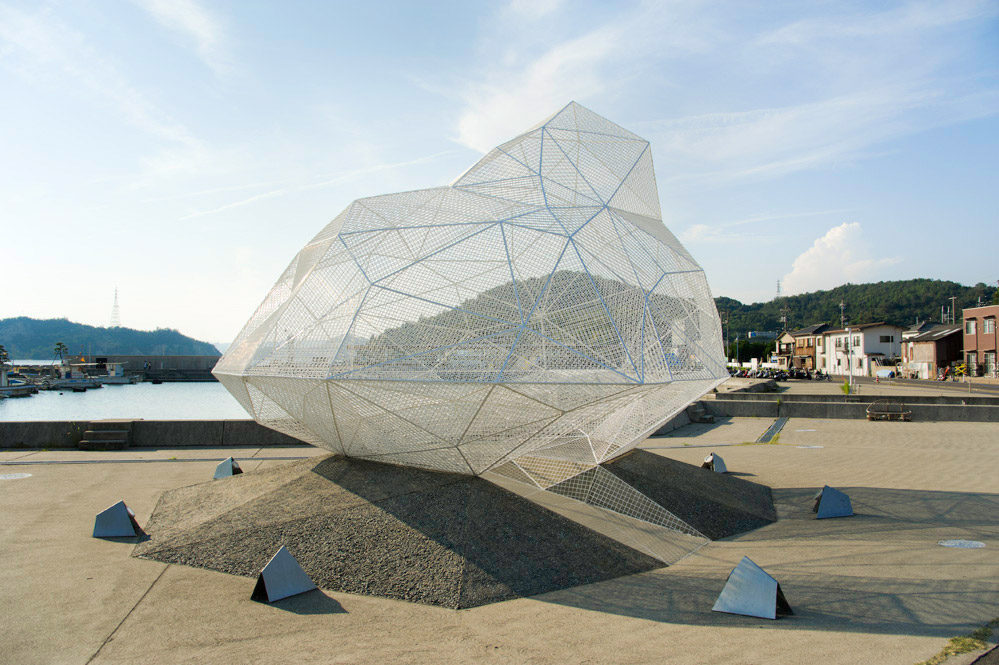
Just a few minutes’ walk around the bay is the Naoshima Pavilion by the Japanese architect Sou Fujimoto.
The Naoshima Pavilion is a large shell-like sculpture which you can enter and sit inside. The playful white metal mesh sculpture is a popular spot for taking photos and is nicely illuminated at night.
From Miyanoura ferry terminal cross the main road and walk down the narrow street next to the TVC bicycle rental shop and you’ll reach Naoshima Bath I Love Yu, one of the islands most eccentric buildings.
A feast for the eyes, the exterior and the interior of Naoshima Bath I Love Yu have been spectacularly decorated by the Japanese artist Shinro Ohtake.
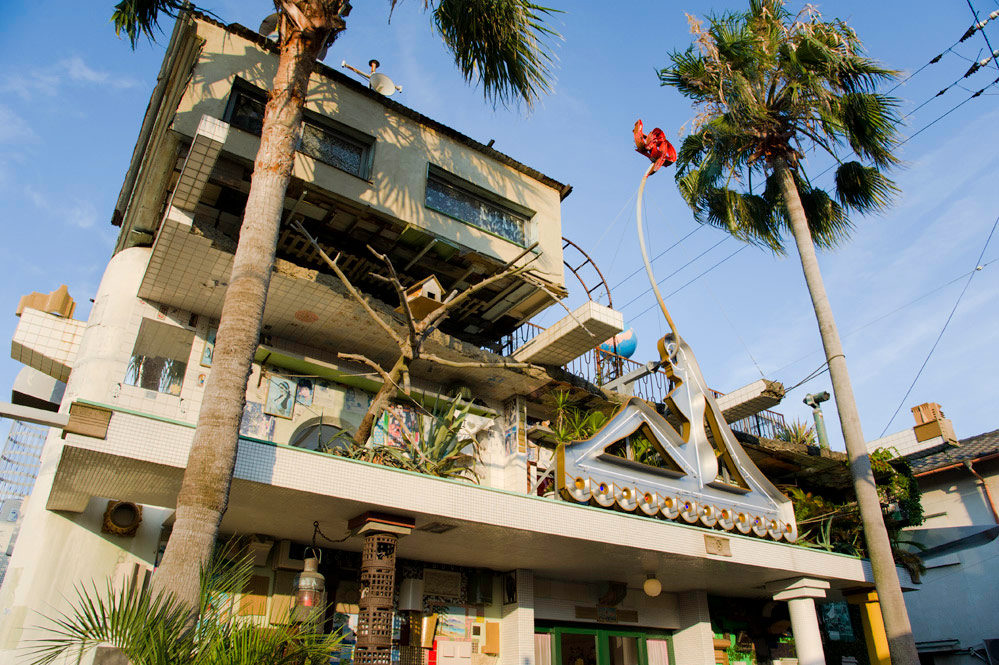
The exterior of the building is an explosion of colour and a variety of artistic and architectural styles. A mishmash of tiles, posters, stickers, lights, found objects, neon, plants and palm trees cover the outside of the building.
The bathhouse’s interior is equally stunning, with colourful mosaics in the tiles of the bath and a fantasy sea-scene painted on to the walls. Most incredible of all is the life-size model of an elephant that stands over the public bath.
Naoshima Public Bath I Love Yu is not just an artwork but a fully functioning bath house. The idea behind the bombastic design was to bring local people and tourists together so that they could interact with each other.
If you fancy trying out a Japanese bathhouse like no other then this is the place for you. There’s also a small shop where you can buy Naoshima Public Bath I Love Yu t-shirts and towels.
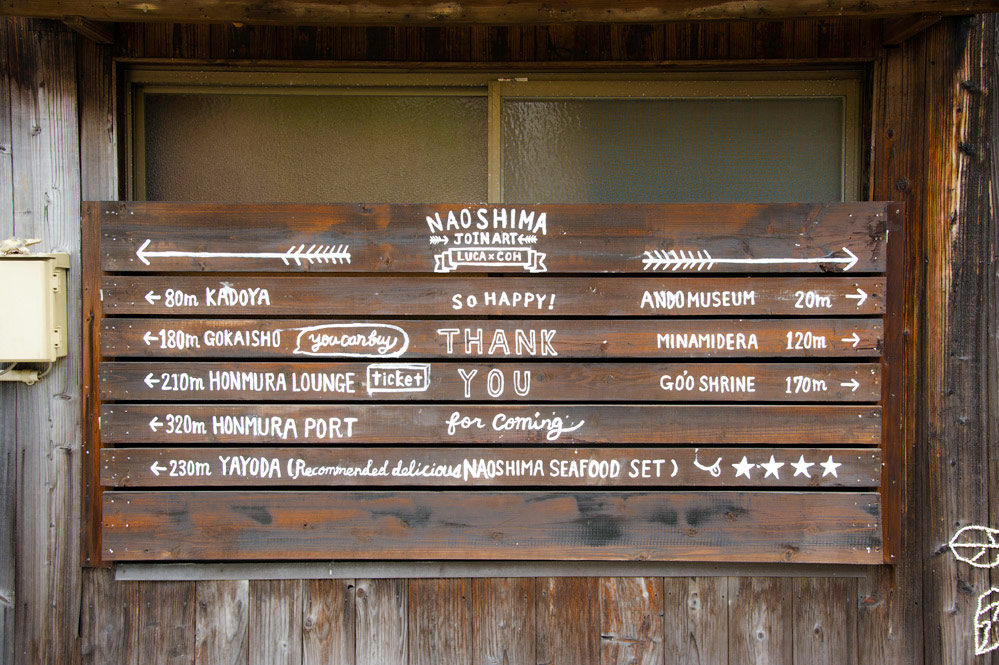
On the west side of the Naoshima is the port of Honmura. Easily reached by bike or bus from Miyanoura, Honmura is where you’ll find Naoshima’s Art House Projects as well as the majority of places to eat on Naoshima.
Naoshima’s Art House Projects are a collection of historic traditional Japanese houses that have been converted into exhibitions that display all kinds of playful and often immersive art installations.
There are seven Art House Project locations around Honmura, all except one of which has been installed in a restored home.
A combined ticket that allows you to enter each Art House Project can be bought at the Honmura Lounge & Archive building that’s a few minutes’ walk from Honmura port.
Out of the seven, here are the must-see Art House Projects that really should be part of every Naoshima itinerary.
Kadoya was Naoshima’s first Art House Project and features the colourful installation called Sea of Time ‘98 by famous Japanese artist Tatsuo Miyajima.
Miyajima’s artwork features dozens of brightly coloured LED numbers counting down at various different speeds on the floor of a main room inside a fully restored 200 year old house.
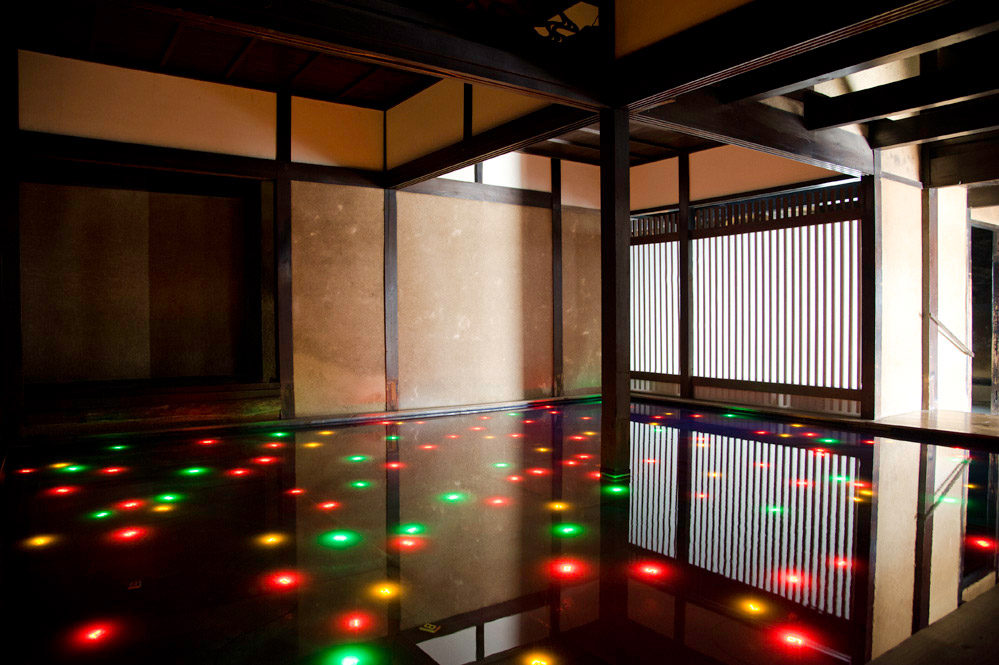
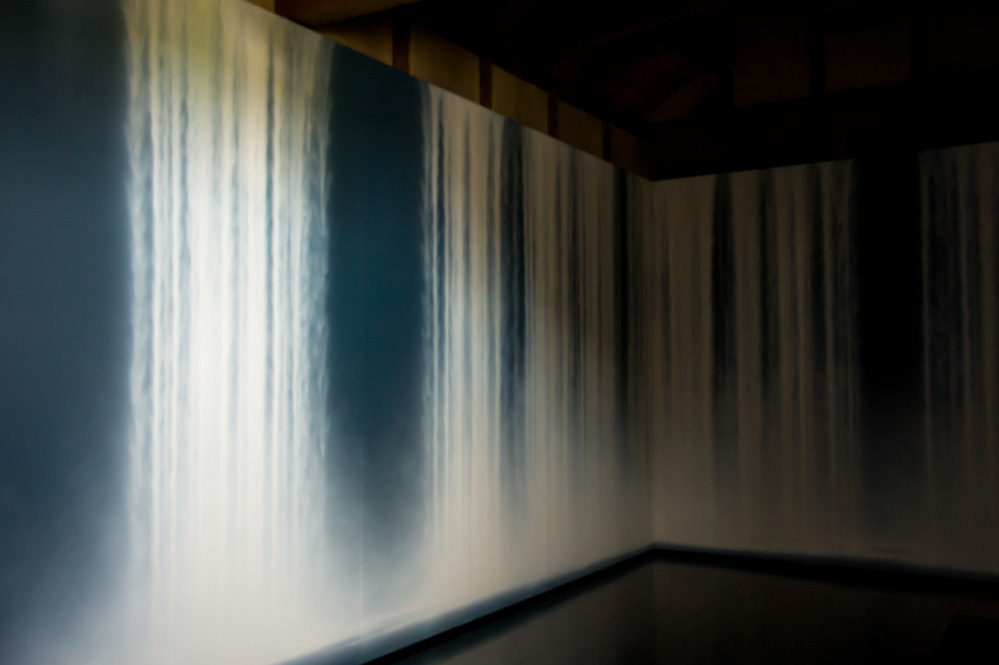
Art House Project: Ishibashi is located inside a grand former home of a salt merchant and was occupied as a house until 2001.
The artworks inside the house are two large-scale waterfall paintings by Hiroshi Senjyu, one of Japan’s most famous artists. The first artworks have been painted onto a set of traditional sliding doors, while the second fill the entire height of two sides of a room.
Art Project House: Haisha is set inside a former dentist’s office and home and has been created by Shinro Ohtake, the same artist behind the Naoshima Public Bath I Love Yu.
Haisha is in exactly the same mould as the bathhouse. The entire house is a fantastic mix of bold and brash artwork where almost anything goes.
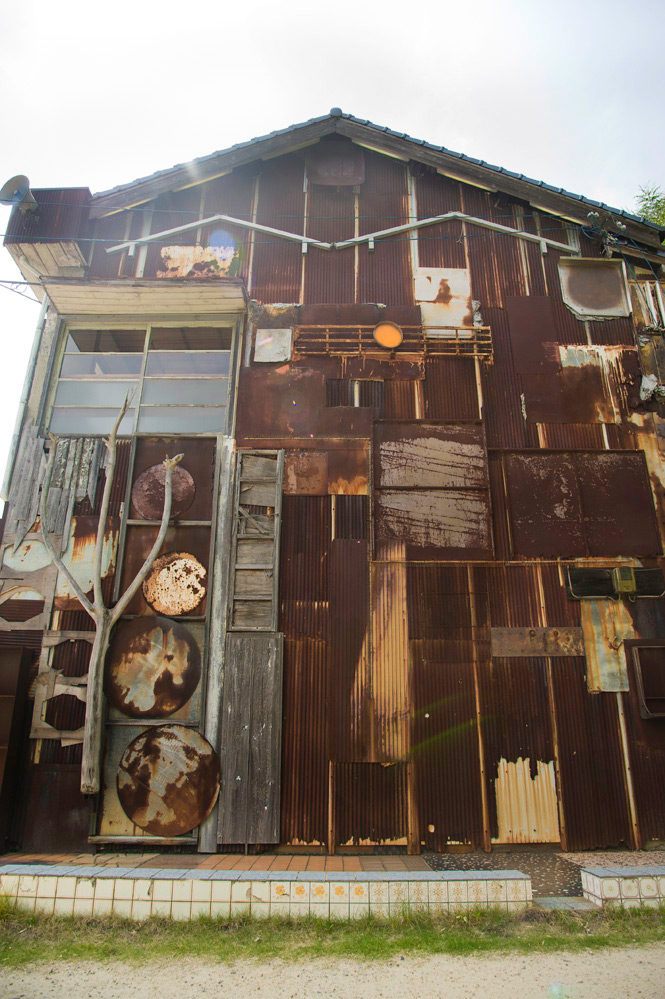
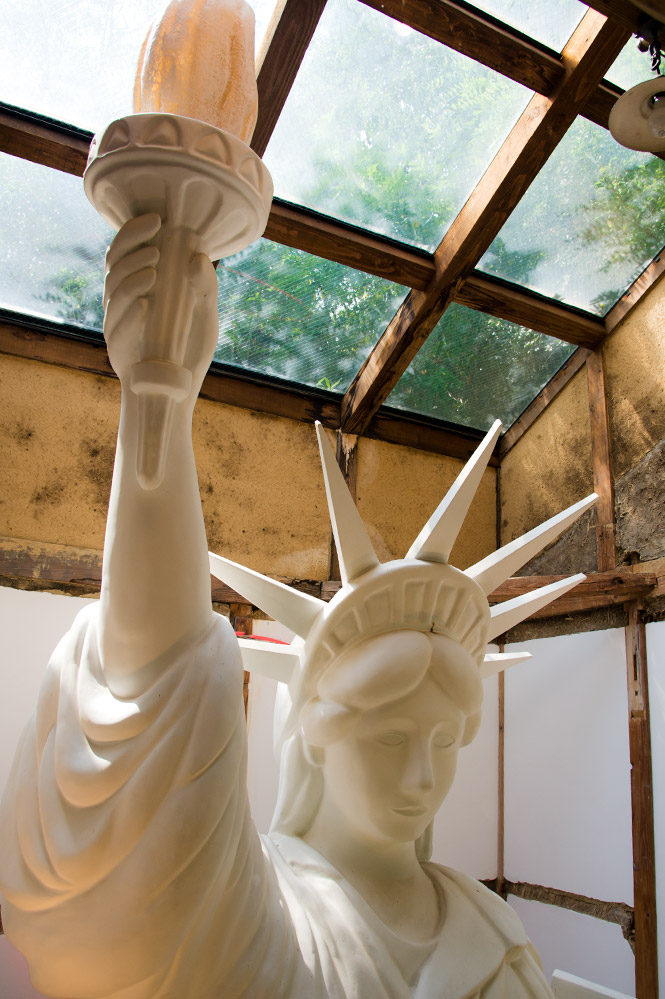
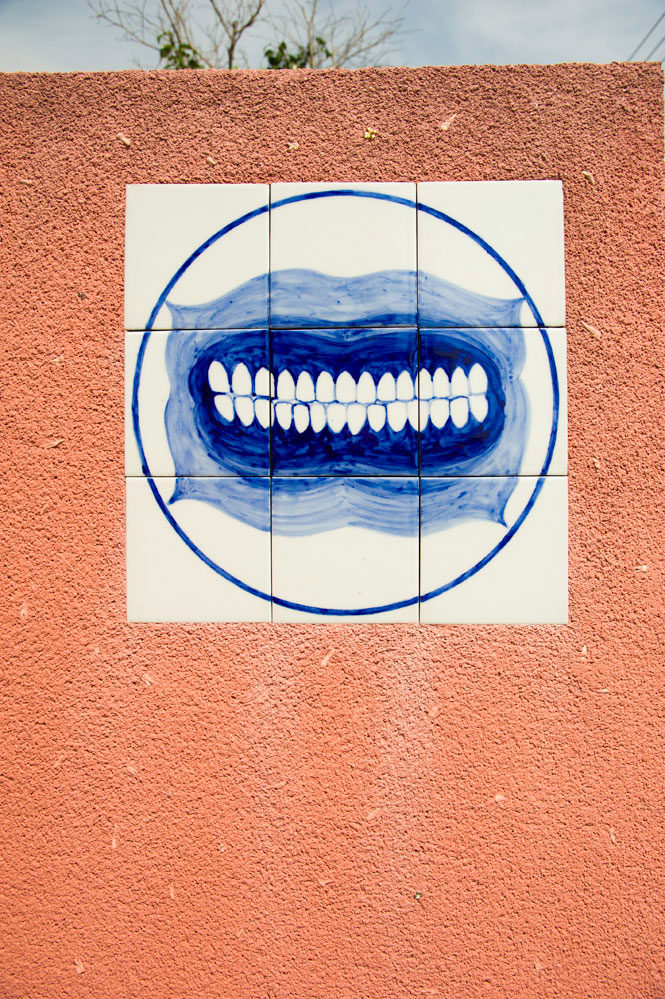
On the walls outside are tiles brightly decorated with teeth that are nods to the building’s former life as a dentist’s office.
Every room inside the building incorporates something completely different from the last, from collage, paintings and even an enormous replica of the statue of liberty.
Created by American artist James Turrell in collaboration with the Japanese architect Tadao Ando, Minamidera is the only Art House Project artwork housed inside a new purpose-built building.
Minamidera is a totally immersive art experience, titled Backside of the Moon, in which visitors sit a long room in near total darkness until light begins to emerge in the distance.
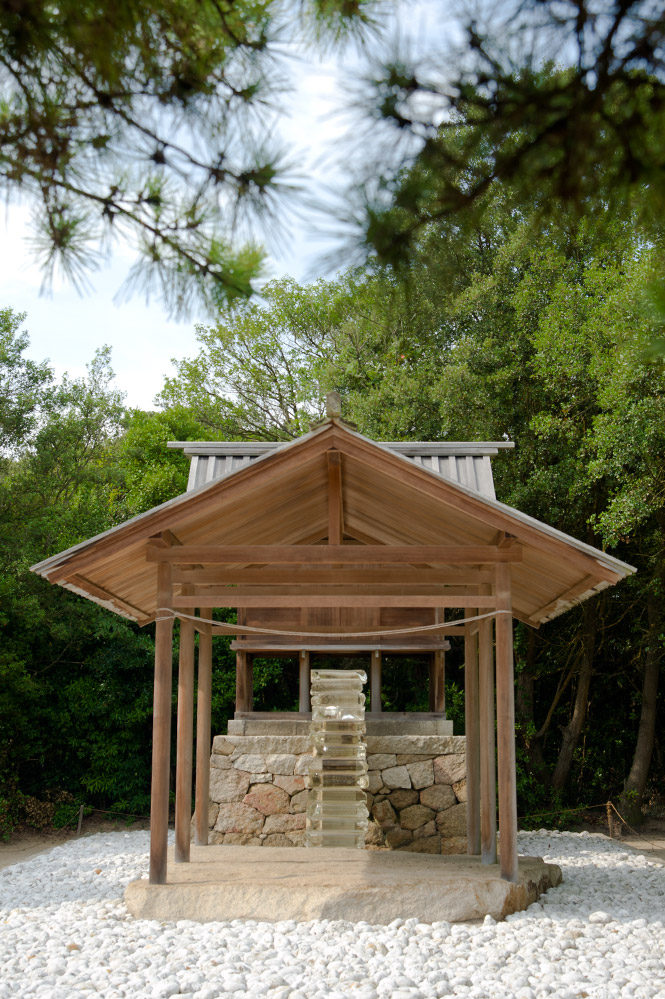
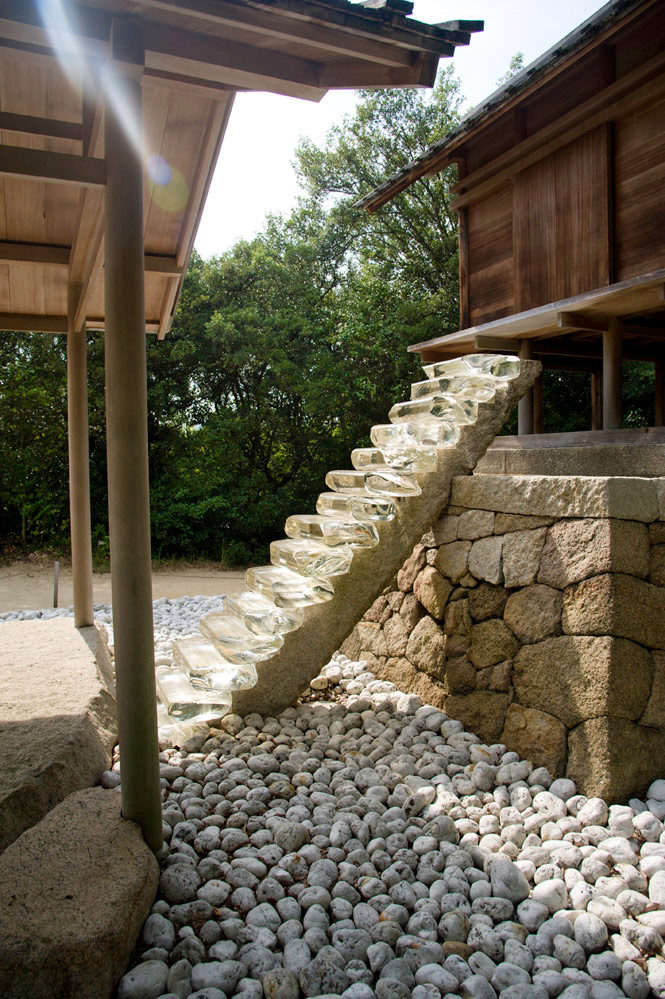
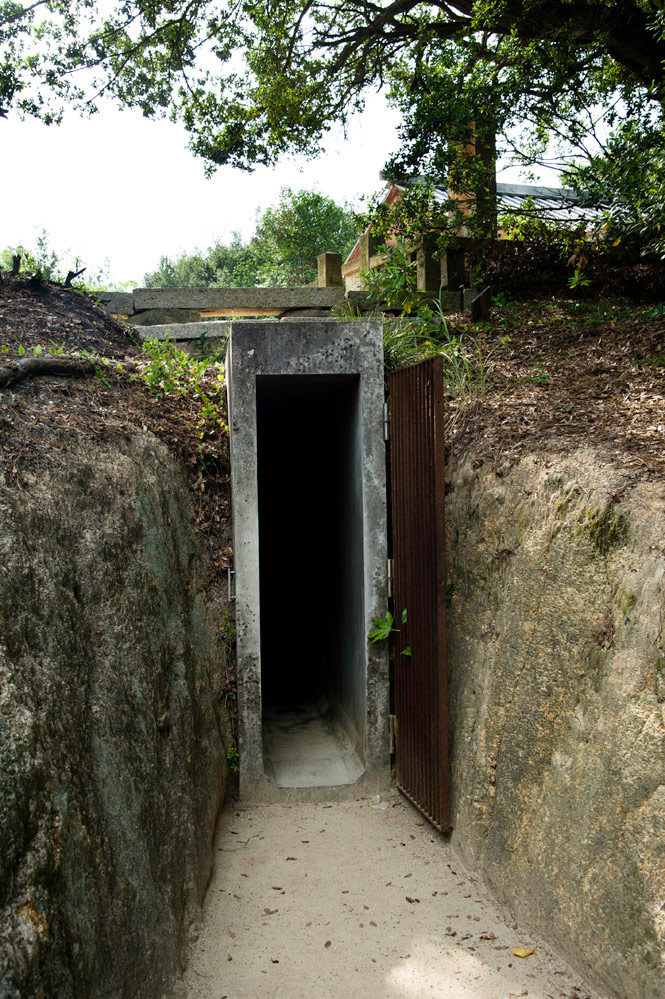
At the top of a winding path through thick trees is the Go’o Shrine, which dates back to the Edo period. As part of the temple’s restoration, artist Hiroshi Sugamoto added a solid glass staircase that descends underground.
Don’t miss the narrow subterranean walkway that leads underneath the temple. In here you can see the lower half of the glass staircase that lies underground. Nearby there are also fantastic views looking out to sea.
Amongst Honmura’s network of old streets is the Ando Museum, another traditional Japanese house that has been given an artistic makeover.
This small 100 year old house has been rejuvenated by Tadao Ando, the world-renowned Japanese architect who designed Naoshima’s three famous art museums.
Along with adding his own personal architectural touch to the house, the museum also displays a number of Ando’s photographs and architectural drawings, documenting the development of Naoshima and the galleries that he designed.
Though there’s not a world of choice there are some great places to eat in Naoshima. The main food options on the island are to be found next to the ports.
Be aware that most places have at least one day a week when they close and many restaurants shut after lunch and reopen in the evening.
Also, opening hours can sometimes be erratic and advertised opening times are often unreliable. Don’t be overly surprised if somewhere isn’t open when online listings suggest they will be.
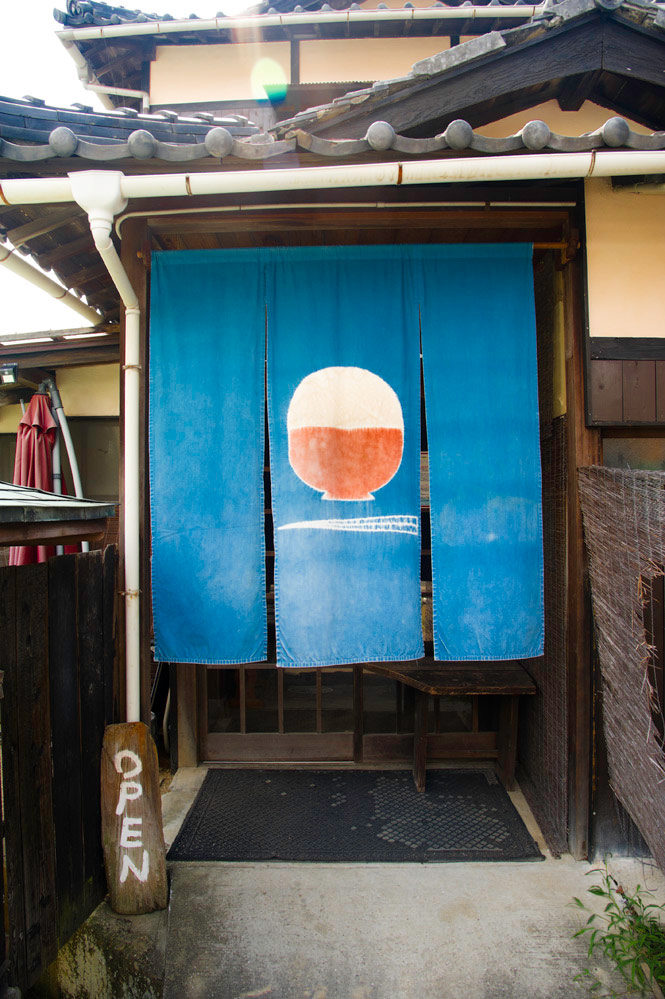
In Miyanoura, just a few minutes’ walk from Public Bath I Love You, Sparky’s Coffee has a great selection of light bites, Japanese meals as well as a great selection of desserts. They also do a great coffee and have a lovely interior.
The family-run Yuunagi, just opposite Miyanoura ferry terminal, is a great place to tuck into fresh, locally caught fish. The deep-fried flounder set is delicious.
In Honmura, the cute and cosy Kon’nichiwa café is set inside a converted home and has a small but varied menu. The Japanese curry and creamy risotto are both packed with flavour.
A few streets away, the vegetarian Aisunao is another restaurant set in a converted home with a lovely atmosphere. The menu is made up of set meals of traditionally cooked rice, pickled and steamed vegetables, tofu and soup.
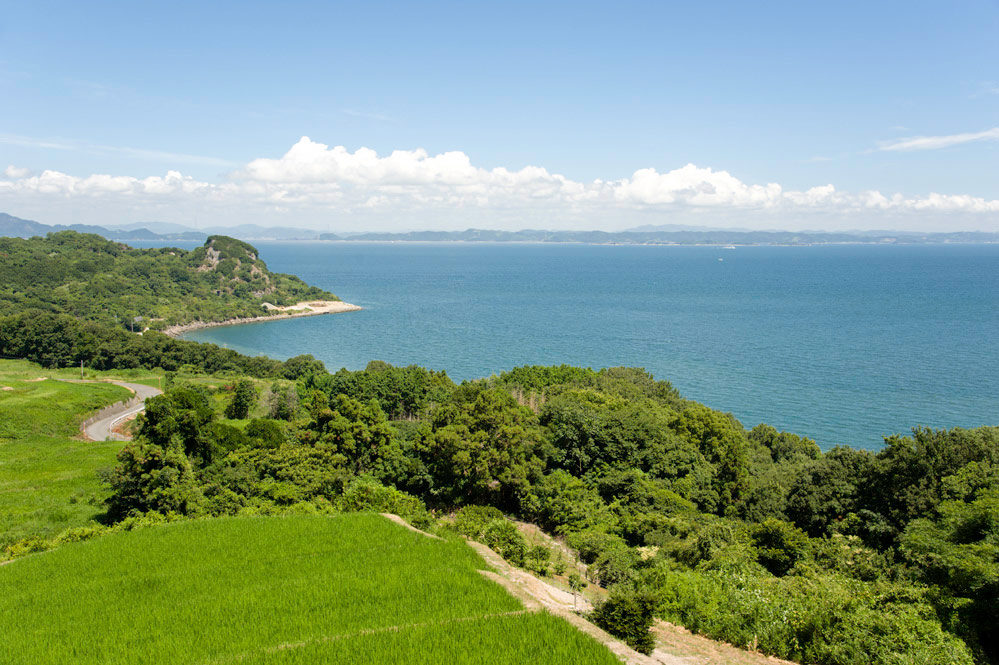
If you’re visiting for more than a couple of days you might want to tack on trips to Teshima and Inujima to your Naoshima itinerary.
Both islands have plenty of fascinating art galleries and stunning scenery to enjoy and are an easy ferry ride from Naoshima.
Be aware though that just like Naoshima, both islands have days where everything is shut. Everything on Teshima is effectively closed on Tuesdays and Inujima is closed from Tuesday to Thursday. Some sites, particularly on Teshima, also closed on other days too.
Whilst there are a few cafés and small restaurants, there’s not a great deal of options for food on either island and there are no convenience stores or supermarkets either.
Both islands are served by ferries from Naoshima’s Miyanoura port. There are three ferries a day calling at both Teshima and Inujima on the same route, stopping first at Teshima before continuing on to Inujima.
However the ferry won’t call at an island on days that they’re closed – so ferries don’t stop at Inujima from Tuesday to Thursday, for example. You can check the ferry timetable here.
The ferry for Teshima and Inujima is a passenger ferry that departs from the smaller port that’s a few hundred metres north of Miyanoura’s main terminal building.
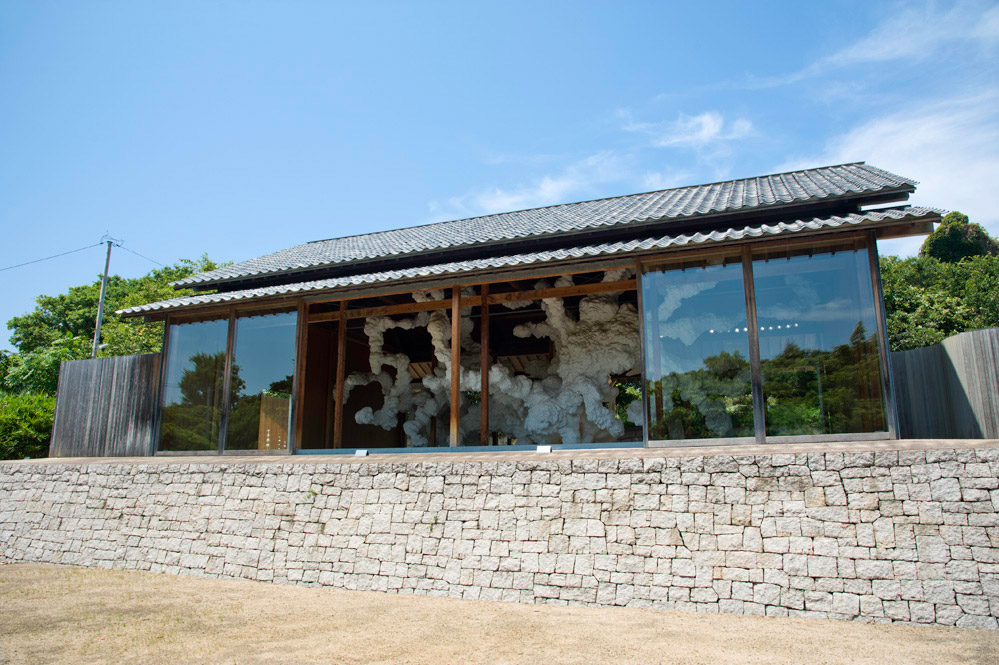
Inujima is small enough that it’s easy to walk between all of the island’s main sights. Teshima is much larger however, and Teshima Art Museum is a fair distance from Iuera port where the ferry drops you off.
Bicycles and e-bikes can be hired from directly outside the ferry terminal building and there are also some public buses – the bus timetable can be found here.
The bus fare is a flat rate of ¥200 per journey. Do be aware that the bus is small and they have a limited capacity – once the bus is full no more passengers will be allowed on.
Car hire is also an option on Teshima, available from Teshima Rent-a-Car located a few minutes’ walk from Iuera port terminal (map here). It costs ¥4000 to hire a car for four hours, which gives you enough time to see the majority of the island.
Teshima is the larger of the two islands and is even bigger than Naoshima.
The main draw to the island is Teshima Art Museum. The museum is another stunning yet remarkably simple immersive collaboration between art and architecture designed and built around the island’s natural beauty.
There are also several smaller art installations similar to Honmura’s Art House Projects as well as some spectacular views of the island’s scenery and the surrounding sea.
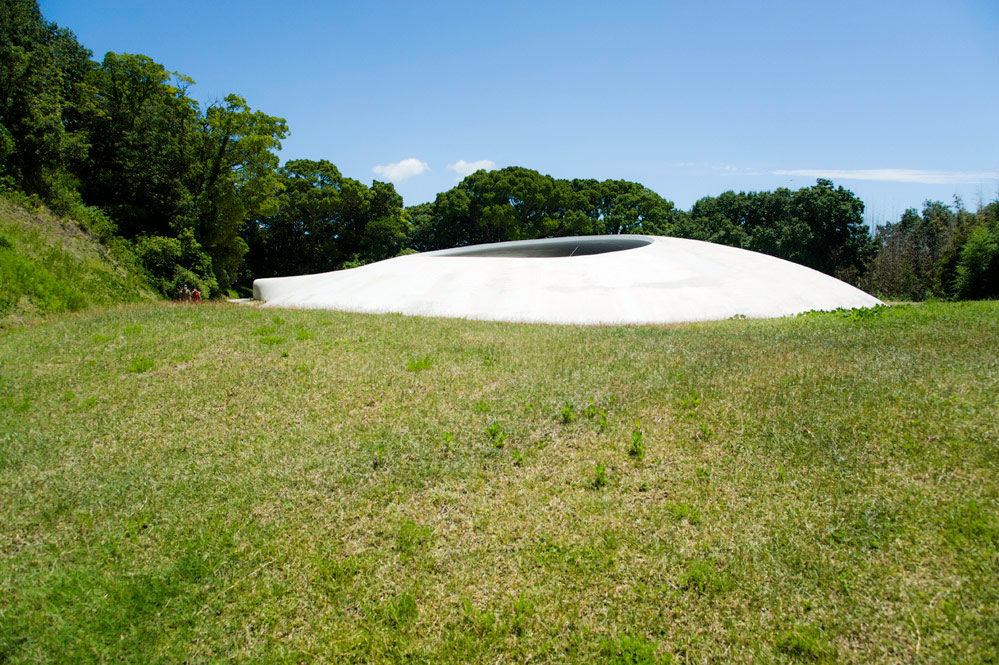
Teshima Art Gallery is the island’s main draw, and just like the main art museums on Naoshima this is another architectural marvel carefully integrated with the surrounding natural scenery.
The gallery’s architecture is also the artwork. The building consists of a single large oval-shaped room with two huge open circles of space in the ceiling at each end. Unprotected from the elements, these also allow visitors an open view of the sky outside.
Throughout the room droplets of water emerge from the sloped floor and slide along the smooth surface to form small clusters of pools that either shift or evaporate in the sun.
An incredibly simple yet peaceful space the Teshima Art Gallery is playful, atmospheric and relaxing in equal measure. Set amongst beautiful rolling hills with wonderful views of the sea, the gallery also a small café and shop next door to the main gallery.
There are several other small art galleries dotted all over Teshima. Many are very remote and have quite erratic opening hours but there are several that are definitely worth seeking out. Here are some of Teshima’s other art galleries worth stopping by.

A short walk from Ieura port, Teshima Yokoo House is a must-see.
A collaboration between the artist Tadanori Yokoo and architect Yuko Nagayama, the grounds and interior of a traditional Japanese house have been transformed with a range of surreal and vibrant artworks.
The large scale paintings and tinted glass are at odds with the house’s traditional wooden beams and tatami mats. In the courtyard, the typical Japanese garden has gone psychedelic.
The outside area is now adorned with golden statues whilst the pond is filled with bold mosaics and the garden’s rocks have been painted bright red.
The Needle Factory has one single artwork, created by Shinro Ohtake, the artist behind Naoshima Bath I Love Yu.
Inside an abandoned sewing needle factory, Ohtake has installed the massive hull of a fishing boat. Over 17 metres long, the hull was made for a boat that was never finished.
Instead the hull sat abandoned for 30 years before being reimagined by Ohtake as the centrepiece for his work inside Teshima’s abandoned sewing needle factory.
A thought-provoking artwork, The Needle Factory hopes to make visitors aware of the island’s former industries and the lives of those who once worked for them. As opening days are inconsistent, it’s best to check here in advance.

On the far eastern end of Teshima is Les Archives du Cœur, an interactive artwork by the French artist Christian Boltanski.
Inside a darkened room lined with mirrors a single lightbulb flashes on and off in time with one of the thousands of heartbeats Boltanski has recorded since he began the project in 2008 (including his own). It’s an eerie experience, and you can even add a recording of your own heartbeat to the collection.
Inujima is a 55 minute ferry ride from Naoshima. Much smaller than Naoshima and Teshima, Inujima is dominated by Inujima Seirensho Art Museum, the remains of a former copper refinery that’s now home to a collection of modern art.
Elsewhere on the island are several more small Art House Projects, similar to those in Honmura in Naoshima.
A ticket must be bought from the ticket centre next to the port that gives entry to the Seirensho Art Museum as well as all of the Art Project Houses on the island.
As Inujima is small and all of the main sites are close together you can easily fit all of the sights into half a day.
Take the first ferry of the day from Naoshima at 9.20 am and you can see everything on the island in time for the 1.10pm return ferry back to Miyanoura.


The semi-derelict former copper refinery that now houses the Seirensho Art Museum mixes Inujima’s industrial past with fascinating modern contemporary art.
Inujima’s copper refinery was built in 1909 and only operated for ten years before a global slump in copper prices forced the site to close. The crumbling furnace towers and the black-bricked remains of the refinery have been incorporated to create an incredible art museum.
A symbol of the modernisation and industrialisation of Japan, artist Yukinori Yanagi has used the remains of the refinery and installed several intelligent and intriguing artworks inspired by the famous Japanese author Yukio Mishima.
A unique and engaging exhibition in an incredible setting, if you have the time during a trip to Naoshima, fitting in a visit to the Seirensho Art Museum is highly recommended.

Around Inujima are a cluster of five Art House Projects, fascinating mini galleries located in or near traditional Japanese houses, all within easy walking distance of each other.
Each house is fairly small and has a letter for a name (e.g, Art House Project S, Art House Project C and so on). Often wildly out of synch with the traditional architecture and the somewhat sleepy nature of rural island life, they’re all worth exploring.
Art House Project F, nearest to Seirensho Art Museum, Art House Project C and Art House Project I are all located inside the frames of original homes.
Art House Project F and Art House Project C both feature extraordinary bold artworks that combine with and fill the entire frame of the old houses.


Art House Project S and Art House Project A are decorative standalone installations located along Inujima’s quiet residential streets. Two grand statement pieces of modern art, they both sit at odds with their rustic surroundings.
Nearby there’s also an elaborate artwork called The Former Site of a Stonecutter’s House painted on the floor where the house once stood. This, along with all of Iujima’s Art House Projects, are on an easy walk that loops back around to the ferry port.
If you’ve liked this post please share it on the socials:
Follow our travels on Instagram here, and keep up to date with our latest posts on Facebook here.
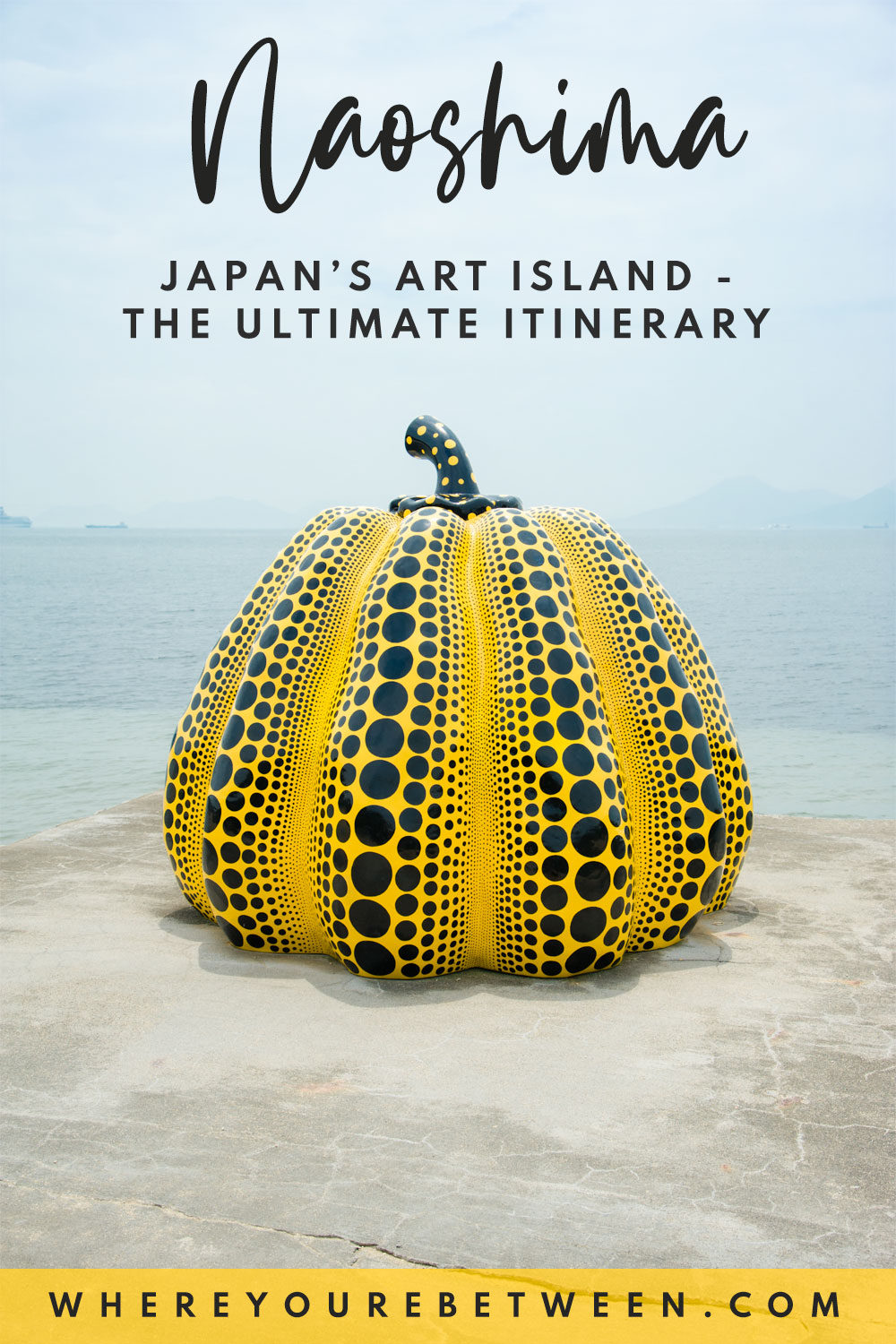
Please note that this post contains some affiliate links. If you click these links and go on to make a purchase we will earn a small commission at no extra cost to you.
© WhereYoureBetween.com – 2023
Cookies help us deliver our services.
By continuing to browse this site, you agree to our use of cookies.
There's a World Out There. Let's Go!
Sign up to our email newsletter for a monthly(ish) dose of wanderlust